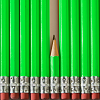There are 25 NRICH Mathematical resources connected to Surface and surface area, you may find related items under Measuring and calculating with units.
Broad Topics > Measuring and calculating with units > Surface and surface areaHow can you change the surface area of a cuboid but keep its volume the same? How can you change the volume but keep the surface area the same?



A plastic funnel is used to pour liquids through narrow apertures. What shape funnel would use the least amount of plastic to manufacture for any specific volume ?



An aluminium can contains 330 ml of cola. If the can's diameter is 6 cm what is the can's height?



How can you arrange the 5 cubes so that you need the smallest number of Brush Loads of paint to cover them? Try with other numbers of cubes as well.



Can you find a cuboid that has a surface area of exactly 100 square units. Is there more than one? Can you find them all?



A spider is sitting in the middle of one of the smallest walls in a room and a fly is resting beside the window. What is the shortest distance the spider would have to crawl to catch the fly?



Imagine a large cube made from small red cubes being dropped into a pot of yellow paint. How many of the small cubes will have yellow paint on their faces?



How many faces can you see when you arrange these three cubes in different ways?



A follow-up activity to Tiles in the Garden.



Can you choose your units so that a cube has the same numerical value for it volume, surface area and total edge length?



How much peel does an apple have?



What is the largest cuboid you can wrap in an A3 sheet of paper?



What's the most efficient proportion for a 1 litre tin of paint?



There are 27 small cubes in a 3 x 3 x 3 cube, 54 faces being visible at any one time. Is it possible to reorganise these cubes so that by dipping the large cube into a pot of paint three times you can colour every face of all of the smaller cubes?



A ribbon runs around a box so that it makes a complete loop with two parallel pieces of ribbon on the top. How long will the ribbon be?



This article outlines the underlying axioms of spherical geometry giving a simple proof that the sum of the angles of a triangle on the surface of a unit sphere is equal to pi plus the area of the triangle.
Which of the following cubes can be made from these nets?



Is it possible to remove ten unit cubes from a 3 by 3 by 3 cube so that the surface area of the remaining solid is the same as the surface area of the original?



According to Plutarch, the Greeks found all the rectangles with integer sides, whose areas are equal to their perimeters. Can you find them? What rectangular boxes, with integer sides, have their surface areas equal to their volumes?




At the corner of the cube circular arcs are drawn and the area enclosed shaded. What fraction of the surface area of the cube is shaded? Try working out the answer without recourse to pencil and paper.



What is the surface area of the tetrahedron with one vertex at O the vertex of a unit cube and the other vertices at the centres of the faces of the cube not containing O?



Choose a box and work out the smallest rectangle of paper needed to wrap it so that it is completely covered.



Investigate the area of 'slices' cut off this cube of cheese. What would happen if you had different-sized block of cheese to start with?


